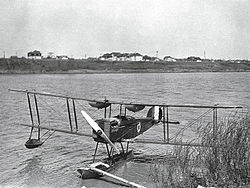Avro 552
| Avro 552 | |
|---|---|

|
|
| Type: | Seaplane , trainer aircraft , multipurpose aircraft |
| Design country: | |
| Manufacturer: | |
| First flight: |
1921 |
| Number of pieces: |
33 |
The Avro 552 was a single-engine biplane made by the British manufacturer Avro .
history
After the First World War , Avro launched a program to modernize the successful, but now outdated, Avro 504 K model . Two unused cells of the 504K were initially equipped with different motors. The first machine, called Avro 548, was equipped with a 80 hp (59,66 kW / 81.11 PS) paid Renault - engine equipped, the other received a 90 hp (67,11 kW / 91.25 hp) Curtiss OX-5 and was named Avro 545.
Comparative tests between the two variants initially led to the decision to use the Renault engine for a light touring aircraft, but work was also carried out on plans for an advanced training aircraft in swimmer design with better flight performance than the 504L.
As thousands of Wolseley Viper engines with an output of 134 kW / 182 PS were available due to the end of the war, which were originally intended for installation in the Royal Aircraft Factory SE5 A, Avro initially built a standard 504K for test purposes an engine of this type. This prototype with the registration G-EAPR was given the type designation Avro 551 and took off on its first flight in October 1920. After extensive flight tests, the machine was modified: for the engine with relatively high fuel consumption , an additional fuel tank was installed in the middle section of the upper wing , a double control was installed, and the shape of the ailerons was changed. After these modifications, the aircraft received the final type designation Avro 552A in the version as a land aircraft. The float version should be named Avro 552A .
On July 16, 1921, the first machine, equipped with a V-shaped chassis, took part in the Aerial Derby in Croydon and finished this race in fifth place. After the race, the undercarriage was replaced by a wooden double float and the machine, equipped in this way, completed demonstration flights in Hamble , which resulted in an order for 13 of these seaplanes by the Argentine Ministry. Production of these machines began in October 1921, and they were used as training aircraft in Bahia Blanca / Argentina until at least 1927. Avro sold two other machines of this type to Bulgaria .
The G-EAPR was rebuilt again in the spring of 1922 and served as a test carrier for various detailed solutions that Avro wanted to incorporate into the type 504N as part of the facelift (for details on the Avro 504N, see Avro 504 ). In this version, the aircraft was temporarily given the designation Avro 552B .
When the Canadian Air Force (RCAF) needed aircraft to monitor forests (Forestry Patrol Aircraft) in 1924 , Avro merged with Canadian Vickers Ltd. a contract that allowed the Canadian manufacturer to build five machines in a single-seat land version (552A); This was followed shortly thereafter by a contract for the license to build nine two-seater seaplanes (552) based on the G-EAPR. Deviating from the Avro development, these aircraft received double floats from the US company US Naval Aircraft Factory and enlarged tanks for a greater range. These Canadian machines retired from active service in 1928.
The proven G-EAPR was granted a further development step - the wings of this machine were removed and in 1927 the fuselage served as the basis for the Autogiro Avro 586 (also known as Cierva C.8V) as part of the cooperation between Alliott Verdon Roe and the Spaniard Juan de la Cierva . After test flights in 1928 and 1929 under the registration number G-ETBX, the machine was sold, converted back into a 552A by the buyer and equipped with the undercarriage known from the 504K with a central runner and support wheels under the wings. With the registration number G-ABGO, the aircraft was sold by Inca Aviation Ltd. until 1933. used for towing banners .
Avro did not manufacture any 552 machines for the UK market. Nevertheless, three copies of this "Viper Avro" called type existed in England; these were built in 1932 by CB Field in Kingswood Knoll in Surrey from parts not used by Avro and also flown by Inca until 1935. The machines were then sold, but only used for a short time by the new owner.
Military users
Technical specifications
| Parameter | Data |
|---|---|
| length | 8.53 m |
| height | 3.18 m |
| Wingspan / upper wing | 10.97 m |
| Wing area | 32.532 m² |
| Max. Weight in flight with a full tank | 1,025 kg |
| Engine | a water-cooled Wolseley Viper engine with an output of 134 kW (182 PS) |
| crew | 2 (one pilot and one passenger or flight instructor and student pilot) |
See also
literature
- Michael JH Taylor: Jane's Encyclopedia of Aviation. Studio Editions, London 1989, p. 93.